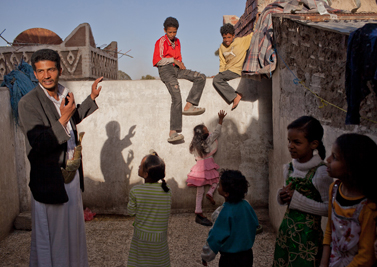Michael Kirby Smith’s unprecedented and intimate look into Yemen
Michael Kirby Smith began photographing what would become A Fractured State, after arriving in Sana’a, Yemen in December 2011. An ongoing journalistic investigation into a nation gripped by conflict and social problems, the project documents a country recovering from a thirty-three year dictatorship and a population struggling with rampant poverty, malnutrition, internal conflicts, environmental issues, an increasing number of refugees from the Horn of Africa, and an expanding U.S.-led covert war against Al Qaeda. Smith gives us an intimate look into an underreported region with the eye of a humanist.
Guernica: What initially brought you to Yemen?
Michael Kirby Smith: When I first started researching Yemen and the rise of its extremist elements, I found there wasn’t enough journalistic coverage of the country and its people. It seemed to be an area without a human face. When the Arab Spring began, I really wanted to be there. There was direct U.S. involvement in the country, which was very important to me. Also, its geopolitical location was really interesting—its proximity to old African trade routes and its fascinating history as an access point to the Middle East.
Guernica: In an age when many journalists travel abroad less and less, and would rather focus on issues in their home region, why do you think producing this work was/is important?
Michael Kirby Smith: Although I obviously see the importance of covering stories in our own backyard—and I’m covering stories here in the States—I feel very passionate about traveling abroad to cover stories. I question the trend of people frowning on traveling abroad to produce work. I understand that argument, but if no one goes then what happens to those stories? I think it’s sometimes good to have perspective from the outside.
Once you arrive, you develop a strong bond to the place and the people. You hear this term “parachute journalism,” but I think it’s problematic for journalists to use that language. It’s important to have the coverage. I think it’s important to expand your knowledge of the world around us.
Going to Yemen was my first trip to the Middle East. Now my entire perspective on the region has changed. I’m far more critical of U.S. policy and involvement. I have informed opinions where I didn’t before.
Guernica: Can you describe one image that sticks with you?
Michael Kirby Smith: It’s definitely the picture where Huddah is crawling up to turn on the light (image #13). That was a special day for me, to be able to spend time with her family in their home. Yemen is a very conservative society, and it is generally frowned upon for a man to spend time in such an intimate setting, especially taking photographs. The city didn’t have consistent power for months, and all of a sudden it was briefly restored. Huddah grabbed a light bulb within seconds. There was something symbolic and significant about her excitement, about seizing this opportunity to turn on the light. It was a beautiful moment.
Michael Kirby Smith lives and works in New York. His editorial clients include the Guardian, the New York Times, The FADER, and Time Magazine. He will be returning to Yemen to work on several projects dealing with the “fractured state” of the country. His work has been exhibited widely in New York City and across the United States.
